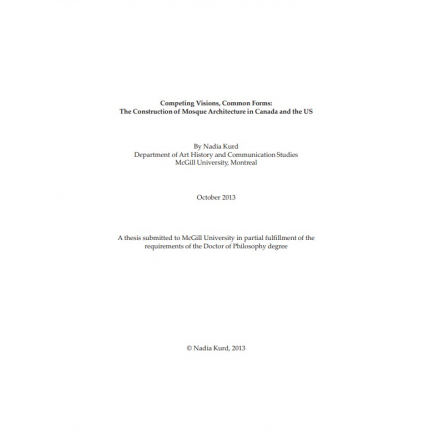From minarets to geometric patterned tiles, the reach and influence of Islamic architectural forms extends far beyond the geographic limits of the Muslim world. Indeed, as early as the eighteenth- and nineteenth- century the architecture and visual cultures of Islam has travelled to North American shores and has affected its built environment. This dissertation examines the making of both the Moorish Revival and mosque architecture in Canada and the US. I argue that these two types of buildings, which have been created by Muslims and non-Muslims alike, show the variability and polarizing nature of contemporary Islamic architecture. For Muslim communities, the primary expression of Islamic architectural ideals is manifested in the building of mosques. In this study, I examine how these contemporary mosques straddle notions of traditional visual and architectural forms with the realities of urban, non-Islamic environments. Through the examinations of mosques that have either been renovated from existing structures and ones that have been purpose-built, I investigate the ways in which these buildings have been responsive to and shaped by the existing architectural norms, political and social circumstances in Canada and the US from the early twentieth century onward. In studying these two contrasting examples of mosques, I argue that a commonality between these structures exists: they both mark a break from the traditional practice of Islamic architecture and reveal a uniquely diasporic Muslim tension with the question of authenticity and difference. These contemporary mosques not only show what is at stake in the use of Islamic architectural tropes but also provide a glimpse of the varied application and amalgamation of built forms by Muslim communities living in Canada and the US. Within Western Muslim communities, debates on the nature of inclusion and agency of women in mosques have also increased in the last decade. The performance of women-led prayers and sermons, most notably led by Amina Wadud, has challenged the segregation of men and women commonly practiced in mosques. Outside the Muslim community, groups such as the Shriners and Masons to wealthy individuals such as aviator-cum-entrepreneur Glenn H. Curtiss and Hudson-school painter Frederic Edwin Church have also made use of the architectural forms associated with Muslim cultures. I look at how built-forms such as the minaret, bi-coloured brickwork and use of hand-painted tiles have been incorporated in their homes and masonic lodges. Although Moorish Revival buildings utilize a visual language similar to those of mosques, they envisioned an Islam wholly through the lens of Orientalism and removed from the racialized realities of North American Muslim populations. Drawing on the work by Edward Said, I examine the lingering legacy of the Moorish Revival and that, when compared to Islamic mosques, and their diverse congregants show the distinct fundamental difference between the two. 





